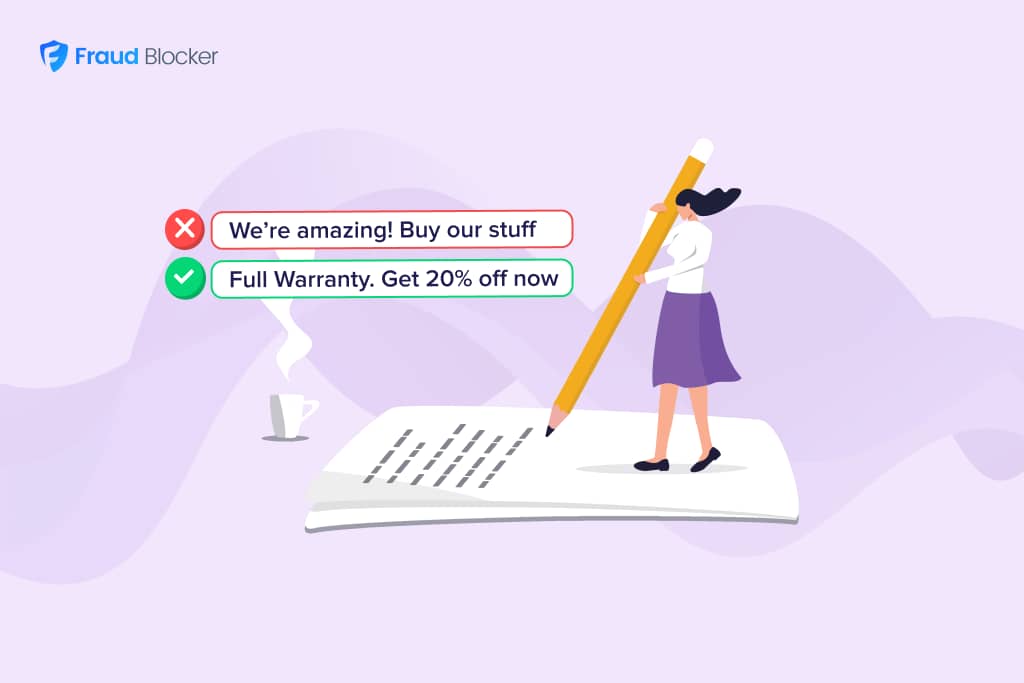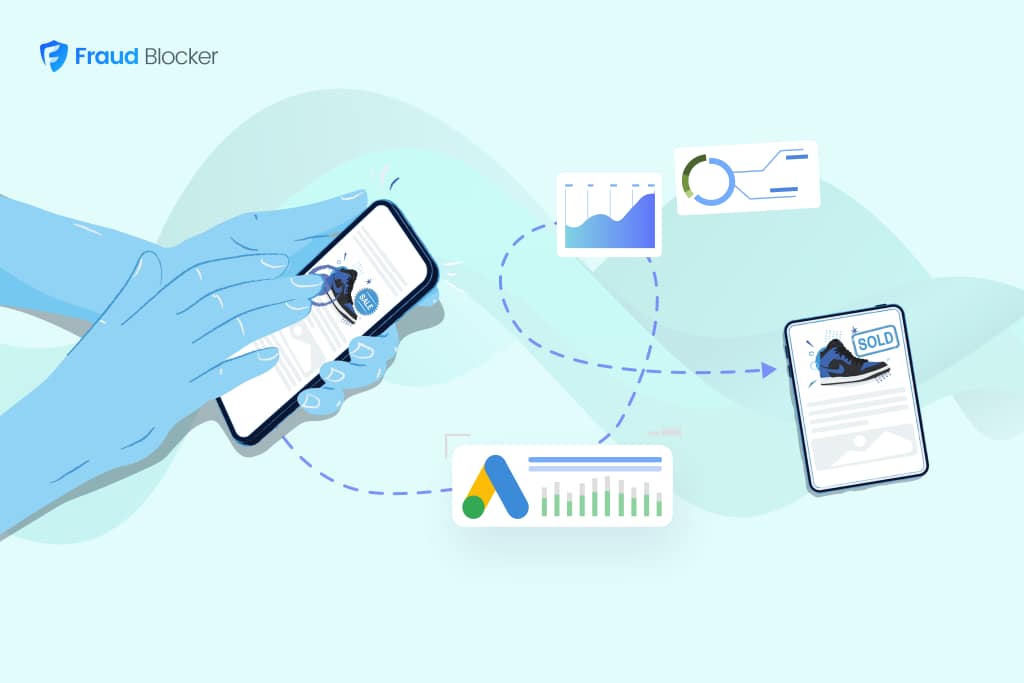
NEW New feature: Verify & block fake emails

We improve your ad performance by blocking click fraud and fake emails

Click fraud is costing advertisers billions in loses. Learn more here.

Click fraud is costing advertisers billions in loses. Learn more here.

Google Ads copy is often the first impression customers get of a business. Get it right, and you’re on your way to ad campaign success; miss the mark, and you could be throwing money away.
This guide is packed with insights on how to write Google Ads copy that stops people in their tracks and gets results. We’ll cover attention-grabbing headlines and irresistible call-to-actions (CTAs) and show some real-life examples of businesses that nailed their Google ads campaign with amazing copy.
Google Ads copy is the short, sharp message that appears in your ads. It’s a mix of headlines, descriptions, and URLs that show up in search results and across the Google Display Network (GDN).
The goal of effective Google search ads copy is to grab attention, be relevant, and get those clicks. Your business is competing for space and paying Google to display your ads, so, every word counts.
Your ads need to:
An effective ad for Google has four sections – headline, description, display url, and CTA.
Let’s see how each of these makes for ads that will generate healthy Return-On-Ad-Spend (ROAS) for your business.
Headlines are your first chance to make a connection. A great headline is clear, to the point, and interesting. It needs to match the user’s search intent, so should contain important keywords. Headlines should also touch on customer pain point to increase the chances of a click.
Your description is where you make good on your headline’s promise. It’s where you show why clicking your ad is worth their time. Keep it brief but compelling. Highlight the following:
If you can, create urgency (think limited-time deals) to give people a reason to click now.
The display URL is the web address users see when they look at your ad. Even if it’s not the exact page they’ll land on, it should make sense with the message in your ad.
Here’s an example of a Google Ad URL: www.yourbusiness.com/leather-jacket
Your ad for leather jackets on sale should have a URL like this to reassure users they’re in the right place, potentially increasing click-through rates.
FYI, the average click-through rate for Google Ads campaigns was 3-5% in 2023.
Google Ads allows you to add “Extensions” to your ad. Here’s a list of all the extensions that you can add to your ad.
Note: Once you have created these elements and activated them, Google may only choose some of them to display on your ad at any one time. This can depend on the position of your ad (top of page typically sees the most ad extensions) or the extensions that receive the best engagement rate.
The Call-To-Action (CTA) tells people what to do next. Make sure it’s crystal clear and action-packed—whether it’s “Shop Now,” “Get a Free Quote,” or “Sign Up Today.” A good CTA stands out and pushes users to act immediately.
Search ad copy should be clear, grammatically correct, and relevant to the offer. Every other ad you’re competing with will have these basics and you don’t want your copy to underperform.
We’ve also found that keeping your copy at an 8th grade reading level is best for performance.
Why? Because 50% of American adults cannot read a book written at an 8th grade level, according to the Washington Post. Plus, simple, direct copy is best for holding users’ attention and guiding them to your CTA.
Customers only care about their problem, and the possible solution. Ad copy that gets clicks need to talk about what they get, not what you’re offering.
Here’s an excellent ad copy example of this:
Speak directly to your customers and answer the question: What’s in it for them?
With this ad, the answer is “avoid large jeweler markups.” The ad also shows an incredible 5 star review and a 25% off deal!
Creating an ad that stands out from your competition is key. To break through the clutter, you may need to try new approaches and strategies.
For example: repetition can be powerful when used smartly (and sparingly). Reinforce key points by repeating important words or phrases throughout your ad copy.
Above is an example of an ad that drives home the point with important keyword repetition. Say it in the headline, repeat it in the description, and maybe even hint at it in the display URL.
Don’t bury the lead. Your value proposition should be the star of the show, not an afterthought. Make sure it’s the first thing people notice, whether it’s:
Or, you may be offering a lifetime warranty, like this ad example here:
Capturing attention and driving clicks isn’t just about what you say—it’s about how you say it. That’s where power words come into play.
Power words are strategic verbs, adjectives, and adverbs designed to trigger emotions and inspire action.
Most of the top performing Google ads use the following power words in their CTA. Studies like the Wordstream one we shared earlier show that these just work:
We’ve also seen that top performing ads echo a positive sentiment in their copy – showing all the great things that will happen once users get their product or service.
The earlier referenced Wordstream study found that almost half of top performing Google ad copy conveys a positive sentiment, and just 2% convey a negative one.
However, ads with negative sentiments often outperform positive ones. An example is the above ad. It saw a 47% increase in CTR when the creative switched to a negative sentiment
The results are clear: Emotions are good, and positive and negative emotions can both be very valuable for Google ads copy.
The Wordstream study also found something interesting – dynamic keyword insertion is often a crutch. Only 10% percent of non-branded ads use it, and 6% percent of non branded ads.
Your marketing campaigns could be better off with advertising copy that sticks to the basics.
Learn More about how Ad Fatigue can undermine your ad performance, even if you nail all these points.
A quick glance at this Monday.com ad makes it clear what’s on offer—an all-in-one project management tool designed to handle anything from simple to complex projects:
Right away, you know it’s versatile, offering tons of templates and integrations, and the ad emphasizes that it’s the top tool in the category.
The CTA (“Try It…”) is subtle but effective, encouraging users to dive in without feeling overwhelmed. Everything about the ad says, “This tool will make your life easier.”
Keep your ads all about the benefits. Don’t just explain what your product or service does—show how it solves problems and makes things easier.
Many businesses will tout they are #1, but not many can back it up like Rare Carat does:
With a perfect 5-star rating and over 1,000 glowing reviews, Rare Carat showcases its credibility and customer satisfaction right off the bat. This immediately reassures potential customers that they’re shopping with a trusted business that’s proven to deliver quality.
The ad doesn’t stop there—it clearly speaks to a pain point of jewelry buying: “large jeweler markups”. By highlighting rings under $1,000 and a 25% discount, the ad again shows the customer it can be trusted to deliver on the promise of affordability.
Social proof can help successful ads stand out in Google search results. Use it to build trust with your target audience. Whether it’s customer reviews, ratings, or testimonials.
This ad from The Fang Law Firm builds a powerful emotional connection right from the headline. It leads with reassurance by addressing a key concern for accident victims—stress:
The emotional appeal continues with a focus on security and trust, with the message “100% Free – Unless We Win.” This gives potential clients peace of mind, knowing they don’t have to worry about upfront costs or financial risk.
Build an emotional connection by addressing your audience’s pain points and offering comfort. Show that you understand their struggles and provide a solution that offers peace of mind, security, and trust.
This Expedia ad speaks directly to the needs of travelers looking for hotel rooms in Tokyo:
The headline gets straight to the point—hotel stays starting at $63—catering to budget-conscious users searching for affordability.
Beyond price, the ad focuses on maximizing value. The phrase “Get the Most Out of Your Trip” appeals to travelers who want more than just a hotel room—it promises package deals and activities, making it a one-stop-shop for planning an entire trip.
When writing need-based copy, focus on the practical desires of your audience. Highlight solutions that cater directly to what your customers are actively searching for and show how your product or service delivers.
Here is Plumber Pros ad that matched to the query “emergency plumber”:
This ad puts the Plumber Pros USP front and center: fast, 24/7 plumbing repairs available now.
Right from the start, it tells potential customers exactly why they should choose this service—immediate availability and responsiveness, no matter the size of the job.
The ad continues to emphasize its USP by offering key features such as “free quotes” and “affordable service,” which cater to a common need—fast, reliable service without hidden costs.
Lead with your USP. Highlight what makes your service or product stand out right from the beginning, then remind users why you’re the best choice.
Here’s another fantastic example of Google Ad copy done right. This monday.com ad nails the customer benefit for the query “team project management” from the start.
Every line clearly highlights how the tool can solve user challenges, whether managing simple tasks or complex projects:
When writing ads, focus on how your product solves your customers’ problems. Instead of simply listing features, explain how each one benefits the user.
This ad from ClickUp is a masterclass in using power words to captivate an audience:
Words like “Free Forever” grab attention by offering a valuable promise at no cost, appealing to anyone looking for budget-friendly project management tools.
There are also other attention-grabbing power words, like:
These deliver a sense of control and capability, making the user feel empowered to handle all aspects of project management in one place.
Use power words that evoke action, value, and efficiency. Terms like “Free,” “Create,” and “Trackable” not only pull attention but also communicate your product’s benefits.
This SEMrush ad cleverly capitalizes on a genius traffic-stealing strategy by targeting users specifically looking for alternatives to their own product.
By positioning itself as the solution to those searching for competing tools, SEMrush draws in users who might be considering other options:
Leverage a traffic-stealing strategy by targeting users searching for alternatives to your product. Address their search directly and showcase why your solution outshines the competition.
There are quite a few problems with the ad below from Best Buy:
First, the headline doesn’t match user intent (see the keyword in the Google search bar).
Plus, the value proposition is very generic and doesn’t highlight the USP at all. Finally, there is a generic CTA that is not related to the user’s search intent. (we have nothing against Best Buy…but their ads leaving something to be desired!)
Spot-check your ads once in a while by conducting real searches to see how your ad displays. This can be useful to spot odd copy or creative combinations with sitelinks and other assets.
Fraud Blocker helps you spot suspicious traffic patterns and block harmful activity, thereby stopping click fraud from draining your Google ads budget.
Acting as a “second line of defense,” our tool helps ensure your ad spend is directed toward real users, improving efficiency and reducing the waste of targeting fake, non-converting clicks.
Google ad headlines are capped at 30 characters each, the descriptions allow 90 characters each, and path fields (display URL add-ons) max out at 15 characters per field.
Write clear, relevant copy at 8th grade reading level. Focus on customer benefits and lead with your value proposition. Additionally, include power words in the CTAs and ensure your copy matches search intent.
Maximize character limits, highlight customer benefits instead of features, use social proof, and organize tight ad groups with 10-20 keywords.


